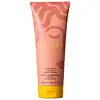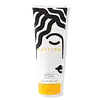What's inside
What's inside
 Key Ingredients
Key Ingredients

No key ingredients
 Benefits
Benefits

 Concerns
Concerns

 Ingredients Side-by-side
Ingredients Side-by-side

Water
Skin ConditioningButyrospermum Parkii Butter
Skin ConditioningCetearyl Alcohol
EmollientGlycerin
HumectantCeteareth-20
CleansingPEG-40 Hydrogenated Castor Oil
EmulsifyingCocos Nucifera Oil
MaskingPEG-120 Methyl Glucose Dioleate
EmulsifyingTheobroma Cacao Seed Butter
EmollientPotassium Sorbate
PreservativeRosmarinus Officinalis Leaf Extract
AntimicrobialHelianthus Annuus Seed Oil
EmollientCaryodendron Orinocense Seed Oil
EmollientCocos Nucifera Fruit Extract
EmollientPrunus Amygdalus Dulcis Oil
Skin ConditioningPEG-60 Hydrogenated Castor Oil
EmulsifyingAloe Barbadensis Leaf Extract
EmollientHydrolyzed Wheat Protein
Skin ConditioningEthylhexylglycerin
Skin ConditioningCaprylyl Glycol
EmollientPolysorbate 60
EmulsifyingCitric Acid
BufferingPhenoxyethanol
PreservativeHydroxyethylcellulose
Emulsion StabilisingDisodium EDTA
Disodium Phosphate
BufferingSodium Phosphate
BufferingSodium Benzoate
MaskingBenzyl Alcohol
PerfumingPhenethyl Alcohol
MaskingSodium Sulfite
PreservativeParfum
MaskingHexyl Cinnamal
PerfumingAmyl Cinnamal
PerfumingHydroxycitronellal
PerfumingGeraniol
PerfumingLinalool
PerfumingCitronellol
PerfumingLimonene
PerfumingWater, Butyrospermum Parkii Butter, Cetearyl Alcohol, Glycerin, Ceteareth-20, PEG-40 Hydrogenated Castor Oil, Cocos Nucifera Oil, PEG-120 Methyl Glucose Dioleate, Theobroma Cacao Seed Butter, Potassium Sorbate, Rosmarinus Officinalis Leaf Extract, Helianthus Annuus Seed Oil, Caryodendron Orinocense Seed Oil, Cocos Nucifera Fruit Extract, Prunus Amygdalus Dulcis Oil, PEG-60 Hydrogenated Castor Oil, Aloe Barbadensis Leaf Extract, Hydrolyzed Wheat Protein, Ethylhexylglycerin, Caprylyl Glycol, Polysorbate 60, Citric Acid, Phenoxyethanol, Hydroxyethylcellulose, Disodium EDTA, Disodium Phosphate, Sodium Phosphate, Sodium Benzoate, Benzyl Alcohol, Phenethyl Alcohol, Sodium Sulfite, Parfum, Hexyl Cinnamal, Amyl Cinnamal, Hydroxycitronellal, Geraniol, Linalool, Citronellol, Limonene
Water
Skin ConditioningCetearyl Alcohol
EmollientGlycol Distearate
EmollientSteartrimonium Chloride
PreservativeCocoglucosides Hydroxypropyltrimonium Chloride
CleansingSimmondsia Chinensis Seed Oil
EmollientRicinus Communis Seed Oil
MaskingPersea Gratissima Oil
Skin ConditioningOlea Europaea Fruit Oil
MaskingMelaleuca Alternifolia Leaf Oil
AntioxidantMel
EmollientCocos Nucifera Oil
MaskingArgania Spinosa Kernel Oil
EmollientPrunus Amygdalus Dulcis Oil
Skin ConditioningButyrospermum Parkii Oil
EmollientPanthenol
Skin ConditioningBiotin
AntiseborrhoeicCopernicia Cerifera Wax
Hydrolyzed Vegetable Protein Pg-Propyl Silanetriol
Skin ConditioningAcetic Acid
BufferingAloe Barbadensis Leaf Juice
Skin ConditioningTocopherol
AntioxidantEthylhexylglycerin
Skin ConditioningTrideceth-3
EmulsifyingTrideceth-15
EmulsifyingPolyquaternium-37
Propylene Glycol Dicaprylate/Dicaprate
EmollientPPG-1 Trideceth-6
Skin ConditioningCetrimonium Chloride
AntimicrobialCitric Acid
BufferingPhenoxyethanol
PreservativeAmodimethicone
Isopropyl Alcohol
SolventParfum
MaskingAlcohol
AntimicrobialPotassium Sorbate
PreservativeDisodium EDTA
Benzyl Benzoate
AntimicrobialWater, Cetearyl Alcohol, Glycol Distearate, Steartrimonium Chloride, Cocoglucosides Hydroxypropyltrimonium Chloride, Simmondsia Chinensis Seed Oil, Ricinus Communis Seed Oil, Persea Gratissima Oil, Olea Europaea Fruit Oil, Melaleuca Alternifolia Leaf Oil, Mel, Cocos Nucifera Oil, Argania Spinosa Kernel Oil, Prunus Amygdalus Dulcis Oil, Butyrospermum Parkii Oil, Panthenol, Biotin, Copernicia Cerifera Wax, Hydrolyzed Vegetable Protein Pg-Propyl Silanetriol, Acetic Acid, Aloe Barbadensis Leaf Juice, Tocopherol, Ethylhexylglycerin, Trideceth-3, Trideceth-15, Polyquaternium-37, Propylene Glycol Dicaprylate/Dicaprate, PPG-1 Trideceth-6, Cetrimonium Chloride, Citric Acid, Phenoxyethanol, Amodimethicone, Isopropyl Alcohol, Parfum, Alcohol, Potassium Sorbate, Disodium EDTA, Benzyl Benzoate
Ingredients Explained
These ingredients are found in both products.
Ingredients higher up in an ingredient list are typically present in a larger amount.
Cetearyl alcohol is a mixture of two fatty alcohols: cetyl alcohol and stearyl alcohol. It is mainly used as an emulsifier. Emulsifiers help prevent the separation of oils and products. Due to its composition, it can also be used to thicken a product or help create foam.
Cetearyl alcohol is an emollient. Emollients help soothe and hydrate the skin by trapping moisture.
Studies show Cetearyl alcohol is non-toxic and non-irritating. The FDA allows products labeled "alcohol-free" to have fatty alcohols.
This ingredient is usually derived from plant oils such as palm, vegetable, or coconut oils. There is debate on whether this ingredient will cause acne.
Due to the fatty acid base, this ingredient may not be Malassezia folliculitis safe.
Learn more about Cetearyl AlcoholCitric Acid is an alpha hydroxy acid (AHA) naturally found in citrus fruits like oranges, lemons, and limes.
Like other AHAs, citric acid can exfoliate skin by breaking down the bonds that hold dead skin cells together. This helps reveal smoother and brighter skin underneath.
However, this exfoliating effect only happens at high concentrations (20%) which can be hard to find in cosmetic products.
Due to this, citric acid is usually included in small amounts as a pH adjuster. This helps keep products slightly more acidic and compatible with skin's natural pH.
In skincare formulas, citric acid can:
While it can provide some skin benefits, research shows lactic acid and glycolic acid are generally more effective and less irritating exfoliants.
Most citric acid used in skincare today is made by fermenting sugars (usually from molasses). This synthetic version is identical to the natural citrus form but easier to stabilize and use in formulations.
Read more about some other popular AHA's here:
Learn more about Citric AcidCocos Nucifera Oil is obtained from the kernels of the coconut fruit. In other words, this is coconut oil.
Coconut Oil is rich in fatty acids with lauric acid making up the majority of these. It also contains linoleic acid. Due to this high fatty acid content, coconut oil helps trap moisture and soften skin.
Despite being antibacterial, coconut oil may not be great for acne-prone skin. It is comedogenic and may clog pores. This ingredient may not be safe for malassezia or fungal acne.
Note: Coconut Oil should not replace your sunscreen for UV protection. Studies show it only blocks about 20% of UV.
This oil is non-volatile and has a light scent.
The term 'fragrance' is not regulated in many countries. In many cases, it is up to the brand to define this term. For instance, many brands choose to label themselves as "fragrance-free" because they are not using synthetic fragrances. However, their products may still contain ingredients such as essential oils that are considered a fragrance.
Learn more about Cocos Nucifera OilDisodium EDTA plays a role in making products more stable by aiding other preservatives.
It is a chelating agent, meaning it neutralizes metal ions that may be found in a product.
Disodium EDTA is a salt of edetic acid and is found to be safe in cosmetic ingredients.
Learn more about Disodium EDTAEthylhexylglycerin (we can't pronounce this either) is commonly used as a preservative and skin softener. It is derived from glyceryl.
You might see Ethylhexylglycerin often paired with other preservatives such as phenoxyethanol. Ethylhexylglycerin has been found to increase the effectiveness of these other preservatives.
Parfum is a catch-all term for an ingredient or more that is used to give a scent to products.
Also called "fragrance", this ingredient can be a blend of hundreds of chemicals or plant oils. This means every product with "fragrance" or "parfum" in the ingredients list is a different mixture.
For instance, Habanolide is a proprietary trade name for a specific aroma chemical. When used as a fragrance ingredient in cosmetics, most aroma chemicals fall under the broad labeling category of “FRAGRANCE” or “PARFUM” according to EU and US regulations.
The term 'parfum' or 'fragrance' is not regulated in many countries. In many cases, it is up to the brand to define this term.
For instance, many brands choose to label themselves as "fragrance-free" because they are not using synthetic fragrances. However, their products may still contain ingredients such as essential oils that are considered a fragrance by INCI standards.
One example is Calendula flower extract. Calendula is an essential oil that still imparts a scent or 'fragrance'.
Depending on the blend, the ingredients in the mixture can cause allergies and sensitivities on the skin. Some ingredients that are known EU allergens include linalool and citronellol.
Parfum can also be used to mask or cover an unpleasant scent.
The bottom line is: not all fragrances/parfum/ingredients are created equally. If you are worried about fragrances, we recommend taking a closer look at an ingredient. And of course, we always recommend speaking with a professional.
Learn more about ParfumPhenoxyethanol is a preservative that has germicide, antimicrobial, and aromatic properties. Studies show that phenoxyethanol can prevent microbial growth. By itself, it has a scent that is similar to that of a rose.
It's often used in formulations along with Caprylyl Glycol to preserve the shelf life of products.
Potassium Sorbate is a preservative used to prevent yeast and mold in products. It is commonly found in both cosmetic and food products.
This ingredient comes from potassium salt derived from sorbic acid. Sorbic acid is a natural antibiotic and effective against fungus.
Both potassium sorbate and sorbic acid can be found in baked goods, cheeses, dried meats, dried fruit, ice cream, pickles, wine, yogurt, and more.
You'll often find this ingredient used with other preservatives.
Learn more about Potassium SorbatePrunus Amygdalus Dulcis Oil comes from the sweet almond, a tree native to Iran. This oil has no fragrance and is non-volatile.
Almonds contain healthy fats, vitamins, and minerals. It is a rich source of Vitamin E, a great antioxidant and skin conditioning ingredient. Sweet almond oil contains fatty acids such as linolenic acid and triglycerides.
The content of sweet almond oil makes it a great emollient; it can help soften and hydrate your skin. Emollients create a barrier over your skin to trap moisture in. Sweet almond oil has antioxidant properties.
Those with an almond allergy should be careful of this ingredient and speak with a professional about using it in your skincare.
This ingredient may not be fungal-acne safe.
Learn more about Prunus Amygdalus Dulcis OilWater. It's the most common cosmetic ingredient of all. You'll usually see it at the top of ingredient lists, meaning that it makes up the largest part of the product.
So why is it so popular? Water most often acts as a solvent - this means that it helps dissolve other ingredients into the formulation.
You'll also recognize water as that liquid we all need to stay alive. If you see this, drink a glass of water. Stay hydrated!
Learn more about Water